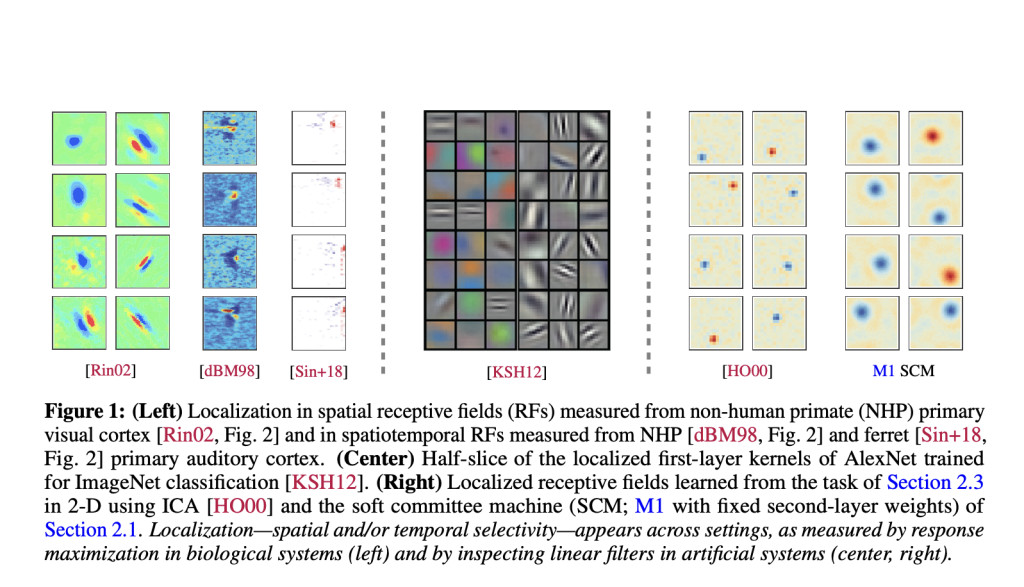

A notable aspect of peripheral responses in the animal nervous system is localization, where the linear receptive fields of simple-cell neurons respond to specific, contiguous regions much smaller than their total input domain. However, localization poses a critical challenge in understanding neural information processing across sensory systems. Traditional machine learning approaches generate weight distributions, that span entire input signals, diverging from biological neural networks’ localized processing strategies. This fundamental difference has motivated researchers to develop artificial learning models, capable of generating localized receptive fields from naturalistic stimuli.
Existing research has explored multiple approaches to address the localization challenge in neural networks. Sparse coding, independent component analysis (ICA), and related compression methods have used a top-down strategy. These techniques aim to generate efficient input signal representations by optimizing explicit sparsity or independence criteria within critically parameterized regimes. It is found that localized receptive fields can develop in simple feedforward neural networks when trained on data models approximating natural visual inputs. Computational simulations reveal that these networks develop increased sensitivity to higher-order input statistics, with even single neurons learning localized receptive fields.
Researchers from Yale University and the Gatsby Unit & SWC, UCL have presented an understanding of the mechanisms behind localized receptive field emergence. Building upon previous work, researchers describe the underlying principles driving localization in neural networks. The paper addresses the challenges of analyzing higher-order input statistics using existing tools that typically assume Gaussianity. By strategically separating the learning process into two distinct stages, the researchers developed analytical equations that capture the early-stage learning dynamics of a single-neuron model trained on idealized naturalistic data. The proposed method presents a unique analytical model that provides a concise description of the higher-order statistical structure driving localization.
The research focuses on a two-layer feedforward neural network with a nonlinear activation function and scalar output. The architecture’s ability to learn rich features has made it a critical subject of ongoing theoretical neural network analyses, highlighting its significance in understanding complex learning dynamics. The theoretical framework establishes an analytical model for localization dynamics in a single-neuron architecture. The researchers identified necessary and sufficient conditions for localization, initially demonstrated for a binary response scenario. Notably, the conditions developed for the single-neuron architecture were empirically validated for a multi-neuron architecture. Also, the proposed architectures would fail to learn localized receptive fields if trained on elliptical distributions.
The research findings reveal critical insights into the localization of neural network weights. When the parameters NLGP(g) and Kur(k) produce a negative excess kurtosis, the Inverse Participation Ratio (IPR) approaches its maximum value of 1.0, indicating highly localized weights. Conversely, positive excess kurtosis results in an IPR near zero, suggesting non-localized weight distributions. For the Ising model, the integrated receptive field precisely matches the simulated field’s peak position in 26 out of 28 initial conditions (93% accuracy). The results highlight excess kurtosis as a primary driver of localization, showing the phenomenon is largely independent of other data distribution properties.
In conclusion, researchers highlight the significant contributions of the analytical approach to understanding emergent localization in neural receptive fields. This approach aligns with recent research that repositions data-distributional properties as a primary mechanism for complex behavioral patterns. Through effective analytical dynamics, the researchers found that specific data properties, particularly covariance structure and marginals, fundamentally shape localization in neural receptive fields. Also, the researchers acknowledged the current data model as a simplified abstraction of early sensory systems, recognizing limitations such as the inability to capture orientation or phase selectivity. These set promising directions for future investigative work for noise-based frameworks or expanded computational models.
Check out the Paper. All credit for this research goes to the researchers of this project. Also, don’t forget to follow us on Twitter and join our Telegram Channel and LinkedIn Group. Don’t Forget to join our 60k+ ML SubReddit.
The post Mechanisms of Localized Receptive Field Emergence in Neural Networks appeared first on MarkTechPost.
Source: Read MoreÂ

 Trending: LG AI Research Releases EXAONE 3.5: Three Open-Source Bilingual Frontier AI-level Models Delivering Unmatched Instruction Following and Long Context Understanding for Global Leadership in Generative AI Excellence….
Trending: LG AI Research Releases EXAONE 3.5: Three Open-Source Bilingual Frontier AI-level Models Delivering Unmatched Instruction Following and Long Context Understanding for Global Leadership in Generative AI Excellence….